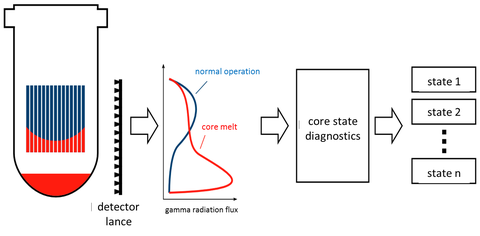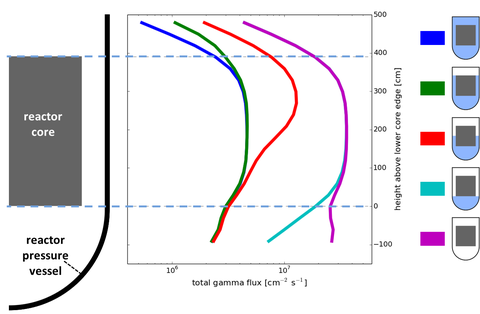Noninvasive State Monitoring of Nuclear Reactors for the Detection of Filling Level Decrease and Core Deformation (NIZUK)
Sub-Project:
Calculation of Gamma Radiation Fields of the Reactor Core
Motivation:
When a nuclear reactor is in operation or shut-down state, the reactor instrumentation provides the required information on the current internal state of the system and its components. Among these data from the operational reactor instrumentation are temperature, pressure and mass flow readings from the primary coolant circuit as well as power information from various neutron detectors. In the case of a severe accident this instrumentation will either fail over time or, as in case of ex-core neutron instrumentation, not be sensitive enough to reveal changes, e.g. in the core. However, the timely optimal implementation of emergency measures would definitely profit from additional core state information.
Objectives:
In the research project, methods for a noninvasive core state monitoring were developed and assessed, which are based on the analysis of the gamma radiation field outside the reactor. For this purpose an additional instrumentation with spatially distributed gamma ray detectors close to the reactor is necessary. The method shall allow detecting a coolant level decrease in the core region and a geometrical change to the core due to an ongoing core melt in real time.
Methods and results:
While after reactor scram the neutron flux of a nuclear reactor is greatly reduced, the decay of short lived radionuclides still produces a considerable gamma radiation flux. The resulting radiation field outside the reactor pressure vessel is determined by the source geometry, that is the fuel assemblies in the core, and the radiation attenuation by reactor internals, pressure vessel and coolant inventory. Especially the hard gamma radiation can penetrate to some degree the massive reactor pressure vessel wall and produce a well measureable photon flux outside, which can be detected with spatially distributed gamma ray detectors.
By means of a comprehensive calculation of gamma radiation fields with Monte-Carlo simulations for an exemplary pressurized water reactor and burn-up, it could be shown that with a vertical detector lance near the biological shield it is possible to securely detect a coolant filling level decrease. In case of a core melt, one can detect and monitor changes to the core geometry and particularly a flow down of molten corium to the bottom of the reactor pressure vessel. One problem that had to be solved is a discrimination of radiation emanating from the core from such emanating from the neutron-activated construction materials. This was solved with a special measuring protocol. Detecting methods to infer core states from the gamma radiation measurements in real-time by the use of soft-computing methods was the work of the project partner University Zittau/Görlitz.

Principle of noninvasive core state monitoring by analysis of the external gamma radiation field.

Gamma radiation flux along the reactor height calculated for a decreasing coolant filling level simulated by the Monte-Carlo method. The radiation attenuation of the coolant varies by one order of magnitude and hence a level decrease is securely measureable.
Publications:
C. Brachem, J. Konheiser, U. Hampel
The gamma radiation emitted by a PWR core under severe accident conditions
Proceedings 22nd International Conference on Nuclear Engineering (ICONE22), 07.-11.07.2014, Prague, Czech Republic
C. Brachem, J. Konheiser, U. Hampel
On the feasibility of using ex-core neutron instrumentation for reactor state diagnosis during accidents
Proceedings 23rd International Conference on Nuclear Engineering (ICONE23), 17.-21.05.2015, Chiba, Japan
